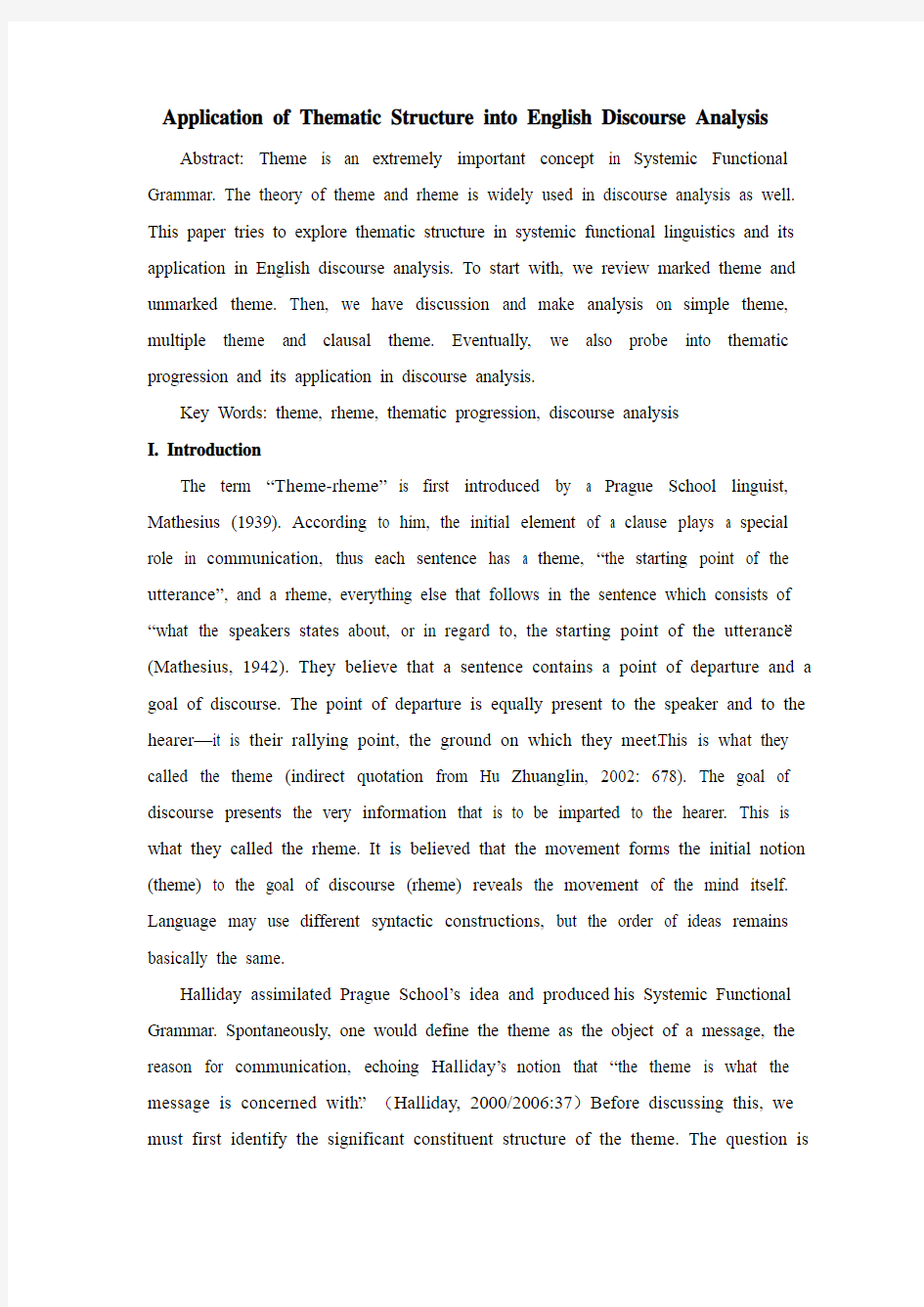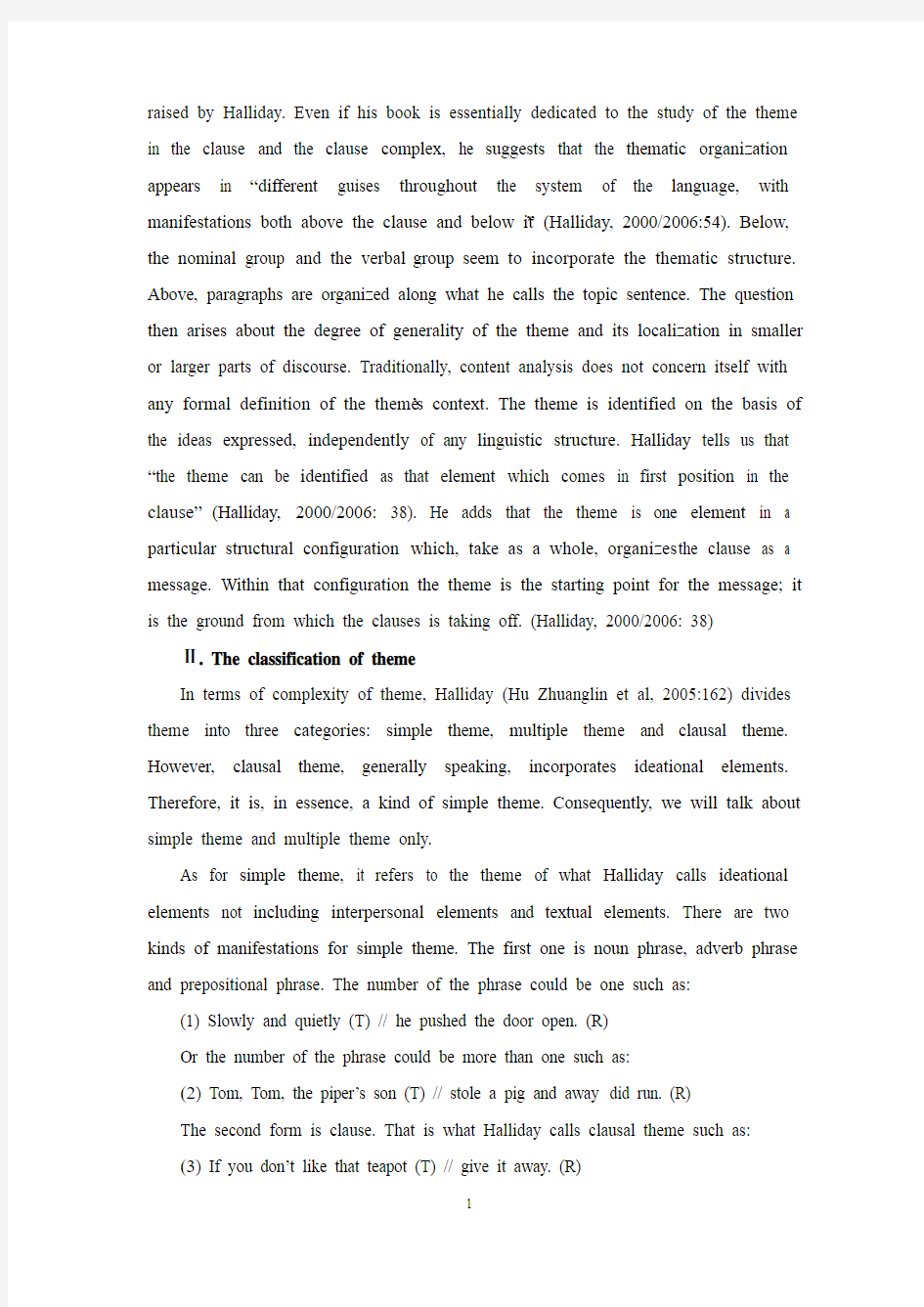Application of Thematic Structure into English Discourse Analysis


Application of Thematic Structure into English Discourse Analysis Abstract: Theme is an extremely important concept in Systemic Functional Grammar. The theory of theme and rheme is widely used in discourse analysis as well. This paper tries to explore thematic structure in systemic functional linguistics and its application in English discourse analysis. To start with, we review marked theme and unmarked theme. Then, we have discussion and make analysis on simple theme, multiple theme and clausal theme. Eventually, we also probe into thematic progression and its application in discourse analysis.
Key Words: theme, rheme, thematic progression, discourse analysis
I. Introduction
The term “Theme-rheme”is first introduced by a Prague School linguist, Mathesius (1939). According to him, the initial element of a clause plays a special role in communication, thus each sentence has a theme, “the starting point of the utterance”, and a rheme, everything else that follows in the sentence which consists of “what the speakers states about, or in regard to, the starting point of the utterance”(Mathesius, 1942). They believe that a sentence contains a point of departure and a goal of discourse. The point of departure is equally present to the speaker and to the hearer—it is their rallying point, the ground on which they meet. This is what they called the theme (indirect quotation from Hu Zhuanglin, 2002: 678). The goal of discourse presents the very information that is to be imparted to the hearer. This is what they called the rheme. It is believed that the movement forms the initial notion (theme) to the goal of discourse (rheme) reveals the movement of the mind itself. Language may use different syntactic constructions, but the order of ideas remains basically the same.
Halliday assimilated Prague School’s idea and produced his Systemic Functional Grammar. Spontaneously, one would define the theme as the object of a message, the reason for communication, echoing Halliday’s notion that “the theme is what the message is concerned with.”(Halliday, 2000/2006:37)Before discussing this, we must first identify the significant constituent structure of the theme. The question is
raised by Halliday. Even if his book is essentially dedicated to the study of the theme in the clause and the clause complex, he suggests that the thematic organization appears in “different guises throughout the system of the language, with manifestations both above the clause and below it” (Halliday, 2000/2006:54). Below, the nominal group and the verbal group seem to incorporate the thematic structure. Above, paragraphs are organized along what he calls the topic sentence. The question then arises about the degree of generality of the theme and its localization in smaller or larger parts of discourse. Traditionally, content analysis does not concern itself with any formal definition of the theme’s context. The theme is identified on the basis of the ideas expressed, independently of any linguistic structure. Halliday tells us that “the theme can be identified as that element which comes in first position in the clause”(Halliday, 2000/2006: 38). He adds that the theme is one element in a particular structural configuration which, take as a whole, organizes the clause as a message. Within that configuration the theme is the starting point for the message; it is the ground from which the clauses is taking off. (Halliday, 2000/2006: 38) Ⅱ. The classification of theme
In terms of complexity of theme, Halliday (Hu Zhuanglin et al, 2005:162) divides theme into three categories: simple theme, multiple theme and clausal theme. However, clausal theme, generally speaking, incorporates ideational elements. Therefore, it is, in essence, a kind of simple theme. Consequently, we will talk about simple theme and multiple theme only.
As for simple theme, it refers to the theme of what Halliday calls ideational elements not including interpersonal elements and textual elements. There are two kinds of manifestations for simple theme. The first one is noun phrase, adverb phrase and prepositional phrase. The number of the phrase could be one such as:
(1) Slowly and quietly (T) // he pushed the door open. (R)
Or the number of the phrase could be more than one such as:
(2) Tom, Tom, the piper’s son (T) // stole a pig and away did run. (R)
The second form is clause. That is what Halliday calls clausal theme such as:
(3) If you don’t like that teapot (T) // give it away. (R)
What traditional grammar called main clause and subordinate clause can be theme in compound sentence. When theme is manifested by a clause, its interior structure incorporates theme-rheme structure such as:
(4) If winter comes (T) // can spring be far behind? (R)
For the element “If winter comes”, “If winter” is the theme whereas “comes” is rheme. For the element “If winter”,“If” is structural element and “winter” is thematic element. In terms of multiple theme, it refers to the theme which consists of multiple semantic elements. It always includes ideational element and may incorporates textual element and interpersonal element. If the three elements can be found in the same theme, the marshaling sequence is usually like this: textual element is prior to interpersonal element whereas the interpersonal element is prior to ideational element.
Textual element in multiple theme incorporates continuative elements such as yes, no, well, oh, now, structural elements such as and, yet, so, even if, however and conjunctive elements such as therefore, in other words, as far as that is concerned.
Interpersonal element incorporates modal element such as certainly, broadly speaking, finite element in interrogative sentence and vocative elements such as John, Mrs. Jones, ladies and gentlemen.
Ideational element refers to topical element which is also called topical theme. Topical theme is the last constituent in multiple thematic structures. The following is a very typical example. Multiple theme incorporates various elements mentioned above.
(5) Well but then Ann surely wouldn’t the best idea (T) //be to join the group? (R)
In the example above, from the beginning to “idea” is multiple theme. The rest is rheme. In the multiple theme, “well”,“but” and “then” belongs to continuative element, structural element and conjunctive element respectively, which express textual meaning. “Ann”, “surely” and “wouldn’t” belong to vocative element, modal element and finite element respec tively, which express interpersonal meaning. “The best idea” is topical element which expresses experiential meaning (Halliday, 2005/2006:55).
Ⅲ. Marked theme and unmarked theme
The expected or “unmarked” theme of an utterance is often stated the subject of
declarative clause, the auxiliary in a yes-no question, the wh-element in a wh-question and the main verb in an imperative clause. For the complex theme, the unmarked order can be stated as textual + interpersonal + ideational. However, people can go beyond this and may place any element in the thematic position in order to achieve various effects, such as highlighting certain element, forming a comparison or contrast, reinforcing the theme or getting textual cohesion. The theme produced in an unusual way is therefore called “marked theme”. Alice Davidson (1980) suggests “the more marked the construction, the more likely that an implicated meaning will be that which the utterance as intended to convey.” For example,
(1) Love (UT) // will come but once in a life. (R)
Sometimes the unmarked theme can be found in interrogative sentence:
(2) With what (UT) // shall I mend it? (R)
If a theme is not the grammatical subject of a clause, the theme is called marked theme (MT) which may be found in declarative sentence and interrogative sentence such as:
(3) Despite the limitations of Sanskrit (MT) // it was in this language that court literature still flourished. (R)
Ⅳ. Application of thematic structure into English discourse
This passage is Across the Channel taken from the New Concept English (Ⅱ). It is mainly introduce the story about Debbie Hart who swims across the English Channel.
(1) Debbie Hart is going to swim across the English Channel tomorrow. (2) She is going to set out from the French coast at five o’clock in the morning. (3) Debbie is only eleven years old and she hopes to set up a new world record. (4) She is a strong swimmer and many people feel that she is sure to succeed. (5) Debbie’s father will set out with her in a small boat. (6) Mr. Hart has trained his daughter for years. (7) Tomorrow he will be watching her anxiously as she swims the long distance to England. (8) Debbie intends to take short rests every two hours. (9) She will have something to drink but she will not eat any solid food. (10) Most of Debbie’s school friends will be waiting for her on the English coast. (11) Among them will be Debbie’s mother, who swam the Channel herself when she was a girl.
4.1 Thematic and information structure
(1)Debbie Hart (T1) is going to swim across the English Channel tomorrow (R1).
In this sentence, T1 and R1 are all belonged to the new information.
(2) She (T1) is going to set out from the French coast at five o’clock in the morning (R2).
Here, T1 is the given information, and the R1 is the new one.
(3) Debbie (T1) is only eleven years old and she hopes to set up a new world record (R3).
Here, T1 is the given information, and the R3 is the new one.
(4) She (T1) is a strong swimmer (R4) and many people (T2) feel that she is sure to succeed (R5).
Here, T1 is the given information, and the R4 is the new one. T2 is the new information and R5 is also the new one.
(5) Debbie’s father (T3) will set out with her in a small boat (R6).
In this sentence, T3 is new information, and R6 is also the new information.
(6) Mr. Hart (T3) has trained his daughter (T1) for years (R7).
Here, T3 is the given information, and the R6 is the new one. Meantime, in the R7, it also contain T1—given information. So it can be marked as follow: T3——R7(T1)
(7) Tomorrow he (T3) will be watching her anxiously as she swims the long distance to England (R8).
In this sentence, T3 is given information, and R8 is the new information.
(8) Debbie (T1) intends to take short rests every two hours (R9).
Here, T1 is the given information, and the R9 is the new one.
(9) She (T1) will have something to drink but she will not eat any solid food (R10).
Here, T1 is the given information, and the R10 is the new one.
(10) Most of Debbie’s school friends (T4) will be waiting for her on the English coast (R11).
Here, T3 is the new information, and the R11 is also the new one.
(11) Among them (T4) will be Debbie’s mother, who swam the Channel herself when she was a girl (R12).
Here, T3 is the given information, and the R11 is the new one.
4.2 Cohesion of the passage
Reference:
Personal Reference: She(2) refers Debbie Hart, Mr. Hart(6) refers Debbie’s father (5);
Demonstrative Reference: the English Channel, the French coast
Conjunction: and, but
Lexical cohesion: Debbie Hart, swim, tomorrow, morning, five o’clock
Ⅴ. Conclusion
Through analyzing the thematic structure, information structure and cohesion of the passage, we know that three methods of discourse analysis are organically combined each other. Thematic structure strategically ties together a number of more specific conception or statements on the basis of particular social forms of knowledge and social forms of perception and belief. From the paper, we know that thematic structure helps to make a text more coherence and also help readers to understand it more clearly.
Reference
[1] Cao Chunchun, Song Wei, Yang Bin. 2005. Discourse Analysis [M]. Shandong University Press.
[2]Michael McCarthy, Ronald Carter. 2004. Language as Discourse: Perspectives for Language Teaching [M]. Peking University Press.
[3] Michael McCarthy. Discourse Analysis for Language Teachers [M]. Cambridge University Press.
[4]宋雅智.主位—述位及语篇功能[J].外语学刊,2008(4).
[5]黄国文.语篇分析概要[M].湖南教育出版社,1988.
